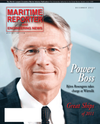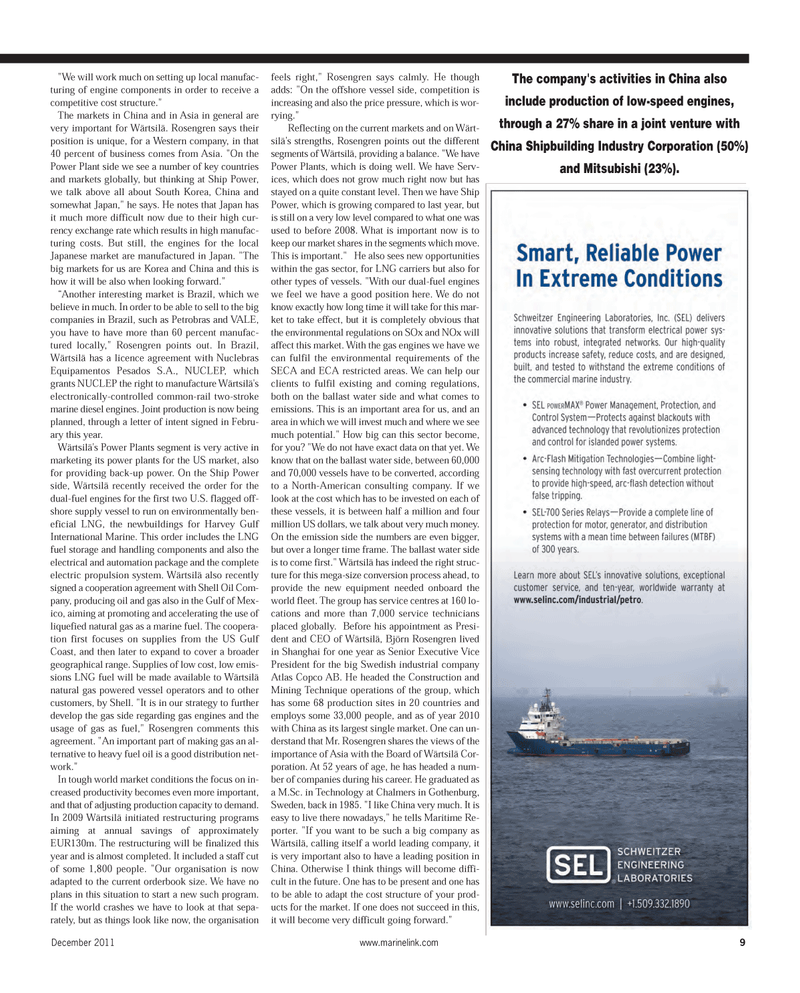
Page 9: of Maritime Reporter Magazine (December 2011)
Great Ships of 2011
Read this page in Pdf, Flash or Html5 edition of December 2011 Maritime Reporter Magazine
"We will work much on setting up local manufac- turing of engine components in order to receive a competitive cost structure." The markets in China and in Asia in general are very important for Wärtsilä. Rosengren says their position is unique, for a Western company, in that 40 percent of business comes from Asia. "On the Power Plant side we see a number of key countries and markets globally, but thinking at Ship Power, we talk above all about South Korea, China and somewhat Japan," he says. He notes that Japan has it much more difficult now due to their high cur- rency exchange rate which results in high manufac- turing costs. But still, the engines for the localJapanese market are manufactured in Japan. "The big markets for us are Korea and China and this is how it will be also when looking forward." ?Another interesting market is Brazil, which we believe in much. In order to be able to sell to the big companies in Brazil, such as Petrobras and VALE, you have to have more than 60 percent manufac- tured locally," Rosengren points out. In Brazil, Wärtsilä has a licence agreement with NuclebrasEquipamentos Pesados S.A., NUCLEP, which grants NUCLEP the right to manufacture Wärtsilä's electronically-controlled common-rail two-stroke marine diesel engines. Joint production is now being planned, through a letter of intent signed in Febru-ary this year. Wärtsilä's Power Plants segment is very active in marketing its power plants for the US market, also for providing back-up power. On the Ship Power side, Wärtsilä recently received the order for the dual-fuel engines for the first two U.S. flagged off- shore supply vessel to run on environmentally ben- eficial LNG, the newbuildings for Harvey Gulf International Marine. This order includes the LNG fuel storage and handling components and also theelectrical and automation package and the completeelectric propulsion system. Wärtsilä also recently signed a cooperation agreement with Shell Oil Com-pany, producing oil and gas also in the Gulf of Mex- ico, aiming at promoting and accelerating the use ofliquefied natural gas as a marine fuel. The coopera- tion first focuses on supplies from the US Gulf Coast, and then later to expand to cover a broader geographical range. Supplies of low cost, low emis- sions LNG fuel will be made available to Wärtsilä natural gas powered vessel operators and to other customers, by Shell. "It is in our strategy to further develop the gas side regarding gas engines and the usage of gas as fuel," Rosengren comments this agreement. "An important part of making gas an al- ternative to heavy fuel oil is a good distribution net- work." In tough world market conditions the focus on in- creased productivity becomes even more important, and that of adjusting production capacity to demand.In 2009 Wärtsilä initiated restructuring programs aiming at annual savings of approximately EUR130m. The restructuring will be finalized this year and is almost completed. It included a staff cut of some 1,800 people. "Our organisation is now adapted to the current orderbook size. We have no plans in this situation to start a new such program. If the world crashes we have to look at that sepa- rately, but as things look like now, the organisation feels right," Rosengren says calmly. He though adds: "On the offshore vessel side, competition is increasing and also the price pressure, which is wor- rying." Reflecting on the current markets and on Wärt- silä's strengths, Rosengren points out the different segments of Wärtsilä, providing a balance. "We have Power Plants, which is doing well. We have Serv- ices, which does not grow much right now but has stayed on a quite constant level. Then we have Ship Power, which is growing compared to last year, but is still on a very low level compared to what one was used to before 2008. What is important now is to keep our market shares in the segments which move. This is important." He also sees new opportunities within the gas sector, for LNG carriers but also for other types of vessels. "With our dual-fuel engines we feel we have a good position here. We do not know exactly how long time it will take for this mar- ket to take effect, but it is completely obvious that the environmental regulations on SOx and NOx will affect this market. With the gas engines we have we can fulfil the environmental requirements of the SECA and ECA restricted areas. We can help our clients to fulfil existing and coming regulations, both on the ballast water side and what comes to emissions. This is an important area for us, and an area in which we will invest much and where we see much potential." How big can this sector become, for you? "We do not have exact data on that yet. We know that on the ballast water side, between 60,000 and 70,000 vessels have to be converted, according to a North-American consulting company. If we look at the cost which has to be invested on each of these vessels, it is between half a million and four million US dollars, we talk about very much money. On the emission side the numbers are even bigger, but over a longer time frame. The ballast water side is to come first." Wärtsilä has indeed the right struc- ture for this mega-size conversion process ahead, to provide the new equipment needed onboard the world fleet. The group has service centres at 160 lo- cations and more than 7,000 service techniciansplaced globally. Before his appointment as Presi- dent and CEO of Wärtsilä, Björn Rosengren lived in Shanghai for one year as Senior Executive Vice President for the big Swedish industrial company Atlas Copco AB. He headed the Construction and Mining Technique operations of the group, which has some 68 production sites in 20 countries andemploys some 33,000 people, and as of year 2010 with China as its largest single market. One can un- derstand that Mr. Rosengren shares the views of the importance of Asia with the Board of Wärtsilä Cor- poration. At 52 years of age, he has headed a num- ber of companies during his career. He graduated as a M.Sc. in Technology at Chalmers in Gothenburg, Sweden, back in 1985. "I like China very much. It is easy to live there nowadays," he tells Maritime Re- porter. "If you want to be such a big company as Wärtsilä, calling itself a world leading company, it is very important also to have a leading position in China. Otherwise I think things will become diffi- cult in the future. One has to be present and one hasto be able to adapt the cost structure of your prod-ucts for the market. If one does not succeed in this, it will become very difficult going forward." The company's activities in China also include production of low-speed engines, through a 27% share in a joint venture with China Shipbuilding Industry Corporation (50%) and Mitsubishi (23%).December 2011www.marinelink.com 9MR Dec.11 # 1 (1-9):MR Template 12/6/2011 4:55 PM Page 9

 8
8

 10
10
